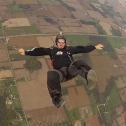Recommended Posts
I'm in that phase of AFF where we are starting to be instructed on being aware of what is outside of the plane when we jump, where the DZ is, etc.
You're right it's a good idea to look around for traffic. You have to admit, it's a big sky and we can make mistakes. At this point I would rather jump out of the plane before looking at an odd angle outside of the plane risking falling out unstable lol.
You're right it's a good idea to look around for traffic. You have to admit, it's a big sky and we can make mistakes. At this point I would rather jump out of the plane before looking at an odd angle outside of the plane risking falling out unstable lol.
Rodriguez Brother #1614, Muff Brother #4033
Jumped: Twin Otter, Cessna 182, CASA, Helicopter, Caravan
Jumped: Twin Otter, Cessna 182, CASA, Helicopter, Caravan
I also stumbled upon this doozy !!! Anyone remember this one . . . http://www.dropzone.com/cgi-bin/gallery/imageFolio.cgi?action=view&link=Video_Vault&image=Bomberflyby.mpg&img=&tt=mpg
You think you understand the situation, but what you don't understand, is that the situation just changed.
QuoteLight aircraft at 2500 agl go about 120-150kts, which means you only have to look through an angle of about 45 degrees. That's easy to do.
That is very misleading. 45 degrees is only true assuming, Zero winds aloft, 120kt speed and roughly 2 miles (10K) of freefall. The other aircraft will be at 45 degrees only at the moment of exit.
Once you consider the approach vector and winds aloft, the aircraft you are looking to avoid is actually more than 2 miles away (more than 45 degrees).
In addition, if first out is spotting traffic for an entire otter load, depending on the number of groups, the spotter is checking for traffic that may be 2 to 5+ miles out.
As a general knowledge question, for the group, how long would you spend scanning 15 to 65 square miles of space looking for a 30 to 65 ft wing?
"Buttons aren't toys." - Trillian
Ken
Ken
billvon 3,058
>45 degrees is only true assuming, Zero winds aloft, 120kt speed and
>roughly 2 miles (10K) of freefall. The other aircraft will be at 45
>degrees only at the moment of exit.
It's still about 45 degrees. Winds aloft don't affect the picture unless winds at the other aircraft's level are significantly different.
>As a general knowledge question, for the group, how long would you
>spend scanning 15 to 65 square miles of space looking for a 30 to
> 65 ft wing?
Generally about 15 seconds.
Try this experiment. Drop an ant on a piece of pavement. Look away for a second, then look back. See if you can find him. Most people can, instantly - even though they are looking for a few-millimeter-long ant from a height of a meter and a half. Why? Because our eyes are excellent at picking moving objects out against a static background.
From altitude, that plane is EASIER to see than that ant when we're standing over it - it occupies more of our field of vision. That's why VFR pilots can safely fly along using only their eyes to detect planes 2 miles away. Indeed, we have a much easier job than they do - we will always see motion against a background, they will only see motion if they are not on a collision course.
As I've said before, getting good at clearing airspace can take some practice. But it's worthwhile to learn how to do it - it can save your life and the lives of the people you're jumping with.
>roughly 2 miles (10K) of freefall. The other aircraft will be at 45
>degrees only at the moment of exit.
It's still about 45 degrees. Winds aloft don't affect the picture unless winds at the other aircraft's level are significantly different.
>As a general knowledge question, for the group, how long would you
>spend scanning 15 to 65 square miles of space looking for a 30 to
> 65 ft wing?
Generally about 15 seconds.
Try this experiment. Drop an ant on a piece of pavement. Look away for a second, then look back. See if you can find him. Most people can, instantly - even though they are looking for a few-millimeter-long ant from a height of a meter and a half. Why? Because our eyes are excellent at picking moving objects out against a static background.
From altitude, that plane is EASIER to see than that ant when we're standing over it - it occupies more of our field of vision. That's why VFR pilots can safely fly along using only their eyes to detect planes 2 miles away. Indeed, we have a much easier job than they do - we will always see motion against a background, they will only see motion if they are not on a collision course.
As I've said before, getting good at clearing airspace can take some practice. But it's worthwhile to learn how to do it - it can save your life and the lives of the people you're jumping with.
riggerrob 643
As I've said before, getting good at clearing airspace can take some practice. But it's worthwhile to learn how to do it - it can save your life and the lives of the people you're jumping with.
>>>>>>>>>>>>>>>>>>>>>>>>>>>>>>>>>>>>>>
We would all be wiser and safer if we all got into the habit of keeping our eyes outside the airplane for most of the ride to altitude. Sure, you need eyes inside for pin checks, or fancy handshakes, but the rest of the time, your eyes should be scanning the skies.





.thumb.jpg.4bb795e2eaf21b8b300039a5e1ec7f92.jpg)
Why? Is there a betting pool somewhere?
Share this post
Link to post
Share on other sites